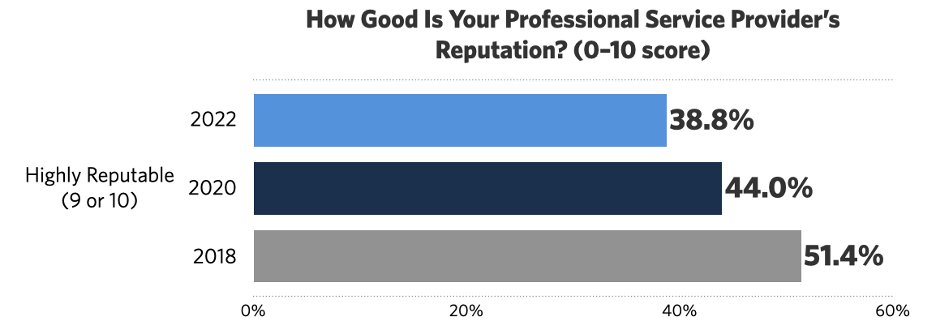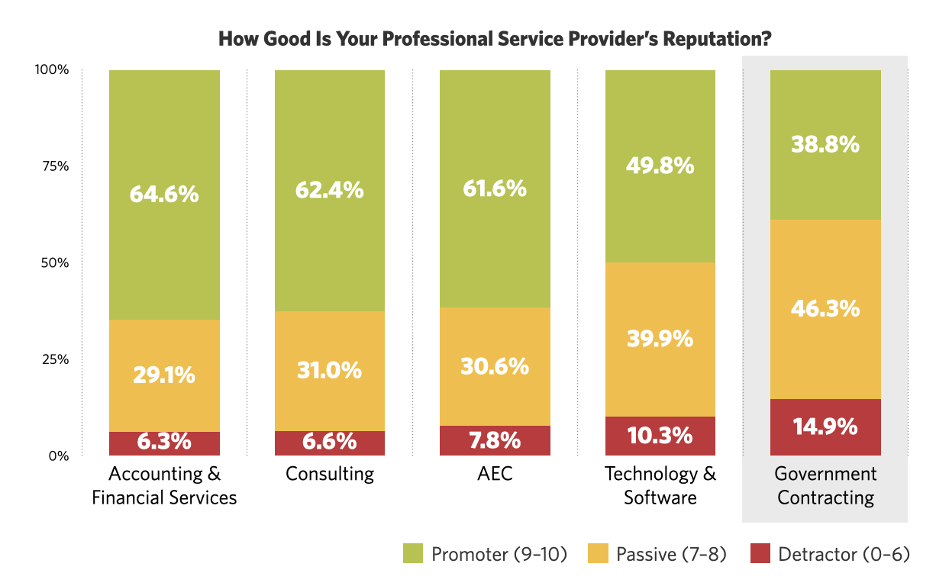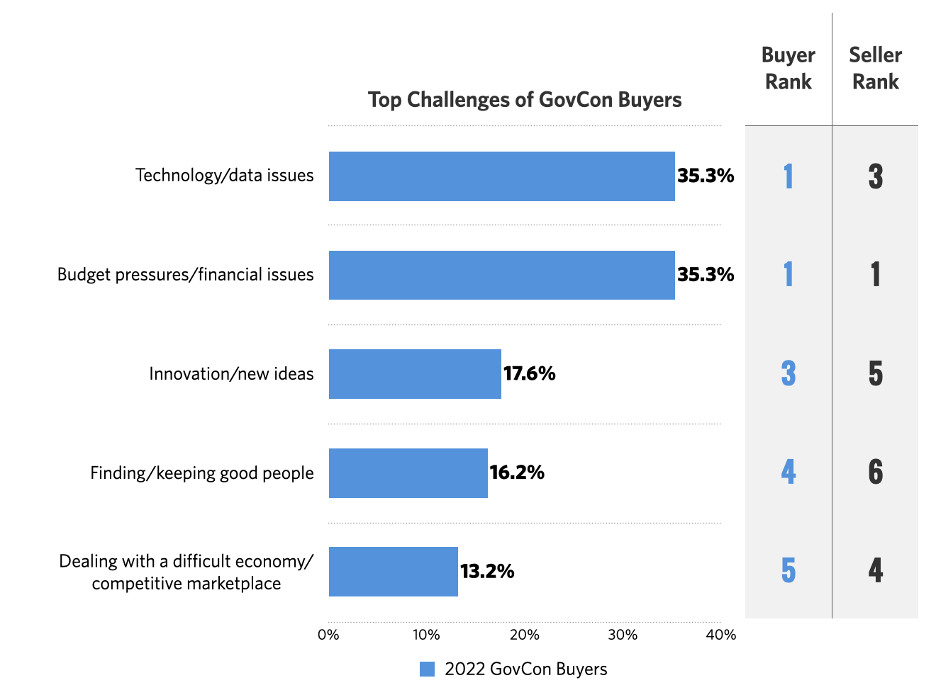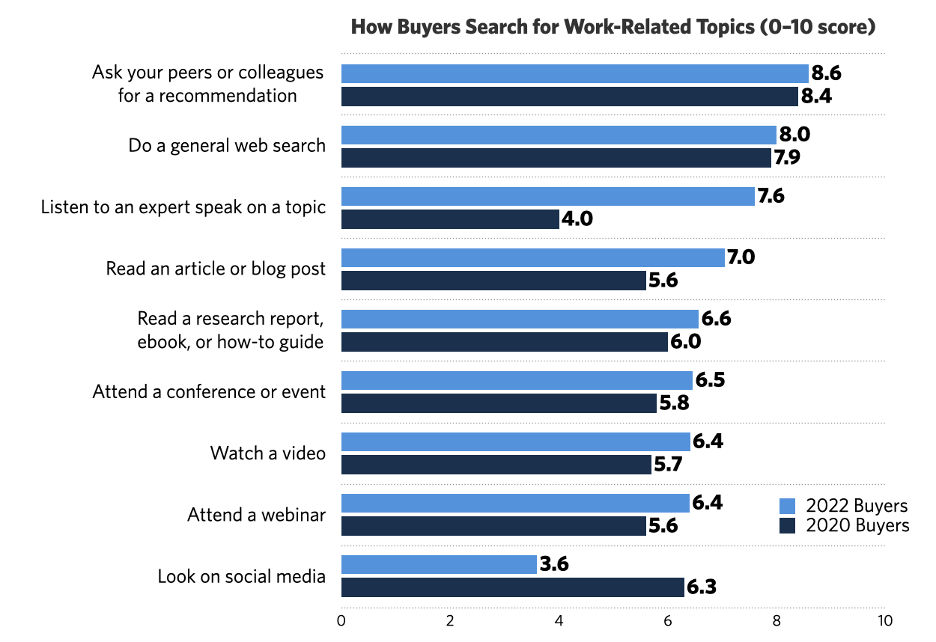As the world emerges from the most acute phases of a global pandemic, economic and geopolitical turmoil cloud the future. During long periods of uncertainty business and government leaders are looking for insights that will help them make decisions with greater certainty and speed.
To address this uncertainty, government contractors must understand how and why their public buyers are behaving differently than in the past.
In our most recent study of buyer behavior, we see that reputation ratings across the industry continue the decline that began more than five years ago. And while overall demand remains strong, government buyers are more price- and value-conscious than they were two years ago. But there is an upside. Our analysis also uncovered opportunities to become more relevant and valuable to public-sector buyers.
About the Research
The Hinge Research Institute has studied more than 40,000 buyers and sellers over the past decade—giving us unparalleled insight into the professional services industry.
Our most recent study of the government contracting industry explores the perspectives of almost 70 buyers and over 140 sellers and examines their perspectives across the following topics:
- How well do sellers of government contracting services really know their buyers?
- What are buyers’ key business challenges?
- How do clients feel about their service providers?
- How do buyers search for service providers?
- How do buyers evaluate service providers?
- How do buyers make their final selection?
Below are four key insights that came out of our report.
Insight #1: The overall perception of government contractors’ reputation continues to decline
When it comes to reputation and value, government contractors are rated lower than all other professional services industries. And government buyers ranked their contractors’ reputations almost 25% lower than they did in 2018 (see chart below). To address this concerning trend, government contractors should pay particular attention to the quality of their service delivery and actively communicate the value they create.


Warren Buffet once said, “It takes 20 years to build a reputation and five minutes to ruin it.” With that sage advice in mind, it would be a good time for government contractors to take notice of this multi-year trend and take proactive steps to reverse it. The good news is that reputation is a perception, not necessarily reality—so for those so inclined, there is an opportunity to take action and change that perception.
Insight #2: Relevancy to solving key issues is greater than other Professional Services
There is some good news in the data. Government contractors are perceived as being more relevant to solving their clients’ challenges than any of the other professional services industries in this year’s study.

So be sure to clearly communicate the value you deliver to your government clients and describe the positive impact you’ve made. This should make closing more business—with both existing clients and new ones—far easier.
Insight #3: Technology and data Issues are a top challenge for buyers.
Today’s government buyers are focused on modernization. Advanced technology and data issues are even more important than many government contractors realize. In the business development process, clearly lay out your technical capabilities, and use case stories to show how you’ve solved similar problems before. To the extent you can, explain how your team, services and expertise are different from your competitors.

To win in a competitive marketplace, your firm needs to first understand what your buyers truly value, then deliver that value in a differentiated way.
Insight #4: Featuring thought leaders within your organization is more important than ever
When it comes to searching for work-related topics, public buyers still ask peers or colleagues for recommendations (a perennial favorite), but they are increasingly seeking out thought leadership, such as listening to an expert speak or reading an article or blog post.

“Look on social media” might be a less popular research method in 2022, but don’t underestimate the power of LinkedIn. It remains the dominant social media platform used by government buyers.
2023 is a year to invest in “standing out from the crowd”
If your professional services firm provides solutions for federal, state or local government—and you hope to improve the quality and profitability of your work while differentiating services in a competitive marketplace—you success may depend on two factors: 1) your ability to objectively understand your buyers (this study can help), and 2) your willingness to adjust your services and pursuit strategy to meet the needs of a changing marketplace. If you can elevate your firm’s value and reputation (especially when it comes to technology and data issues), your organization can rise above the common government services firm.
To get the full study and recommendations, purchase the full study, Inside the Buyer’s Brain, Fourth Edition: Government Contracting.
How Hinge Can Help
To learn more of the findings from our Inside the Buyer’s Brain research, be sure to download the free Inside the Buyer’s Brain Executive Summary. You may also want to consider purchasing the full Inside the Buyer’s Brain study (available in five industry editions) or license a full study so that you can use the content in your marketing campaigns over the next 12 months. Contact the Hinge Research Institute for more details.


